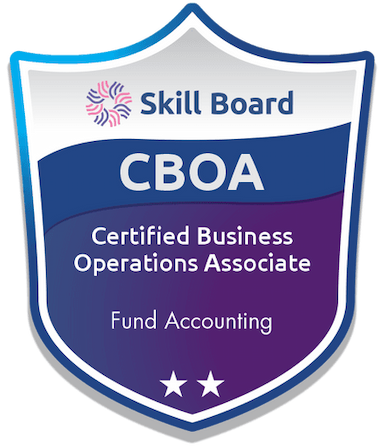- Students aspiring to pursue a career as Fund Accountant
- Business Analysts and QAs working in custody and asset servicing.
- Business Operations Associates working in investment management, custody and asset servicing firms
- Knowledge of Securities Products and Valuation of Securities.
- Knowledge of the Chart of Accounts and General Ledger (GL) preparation for an Investment Fund.
- Understanding of the Trade Lifecycle, the impact of Corporate Action events on NAV, and Reconciliation Control
- Knowledge of NAV Calculation, including the calculation of Management Fees and Performance Fees.
- Distribution of Income and Capital Gains.
- Certified Associates are required to either rectify after 3 years either by taking a recertification assessment or through continuing education credits
- Continuing education credits may be earned by taking up equivalent or higher industry certification.
| Domain | Weightage |
|---|---|
Securities Basics and Trade processing Basics of Investment Instruments and Valuation of Securities Products, Securities Trade Booking and the Lifecycle of a Securities Trade, Securities Trade Settlement. | 10 - 20% |
Portfolio Accounting and NAV calculation Fundamentals of Equity, Fixed Income, FX, Exchange Traded Derivatives, OTC Derivatives products. Pricing and Valuation of Financial instruments, Steps in NAV Calculation, Journal Entries and Accounting for Capital Stock Activity, Expenses, Income,, Corporate Actions, Fund Distributions, Trade Settlement and Funding. Accounting for International investments, FX settlements, Accounting for Mark to Market changes. | 30 - 50% |
Control processes in NAV computation Trade Review, Reconciliation - Cash and Securities Recon, Mark to Market, NAV Impact Analysis, Fund Pricing policies | 20 - 30% |
Tax lot accounting Computing capital gains using FIFO , LIFO, Average Cost, Identified lot, Highest cost first out, Lowest cost first out. | 0 - 10% |
Hedge Fund Accounting Hedge Fund Structures, Hedge Fund Accounting fundamentals, GAV v/s NAV, Concept of Hurdle Rate, Management Fee and Performance Fee calculation, Equalization concepts - Series of Shares method and Equalization Credit Method. Fund Statements and Financial Reporting | 0 - 10 % |
Private Investment Accounting Core concepts in Partnership Accounting, Business of Private Equity and Private Credit, Private Equity Financial Transactions, Financial Statements and Cash Flow management. Accounting for Capital Commitment and Capital Calls, Distribution concepts (Preferred Return and Carried Interest calculation and Performance Fees Waterfall distribution), Fund Performance Metrics - IRR and MOIC, Accounting for Subscription lines of credit (Subline) and Impact on Fund Performance, PE Investment Valuation concepts | 0 - 10 % |

